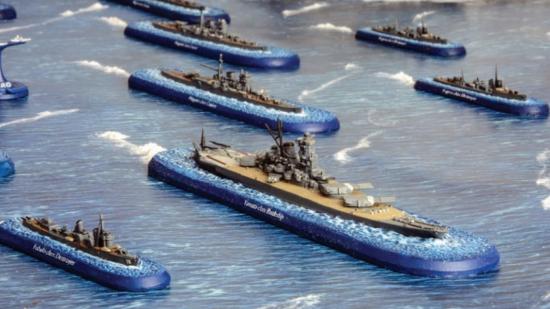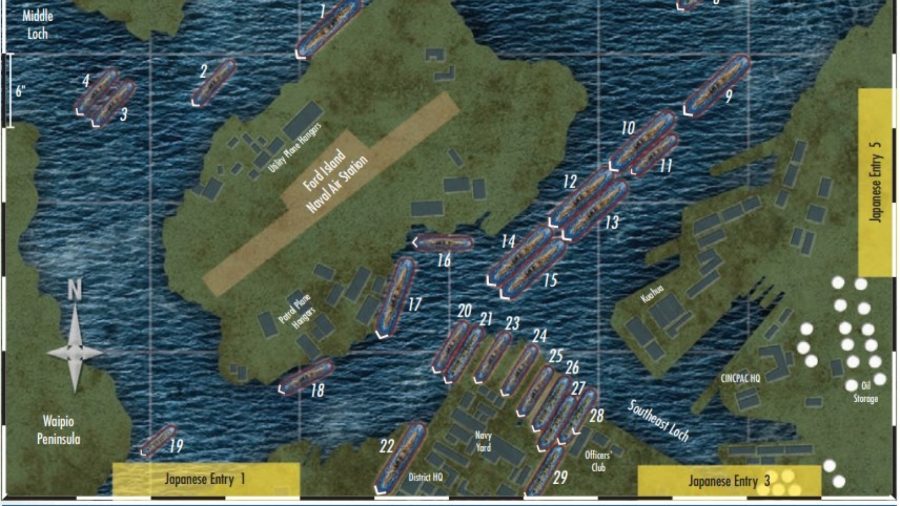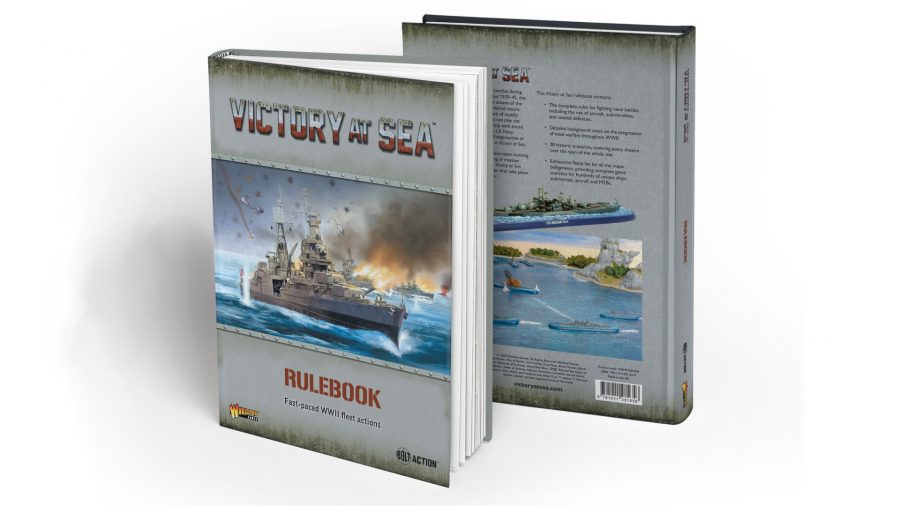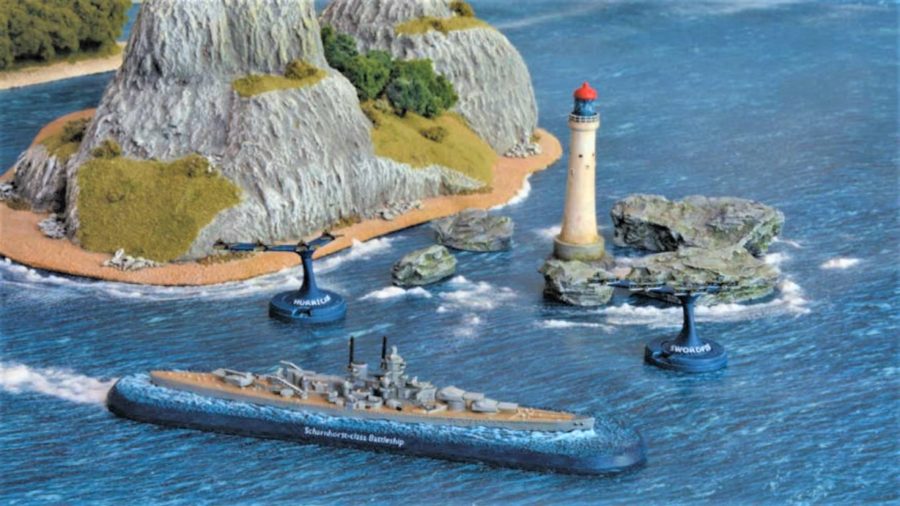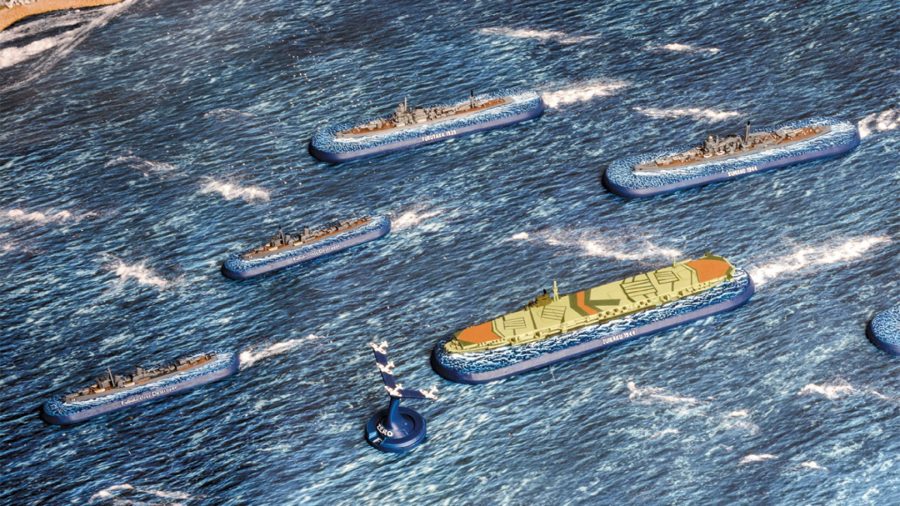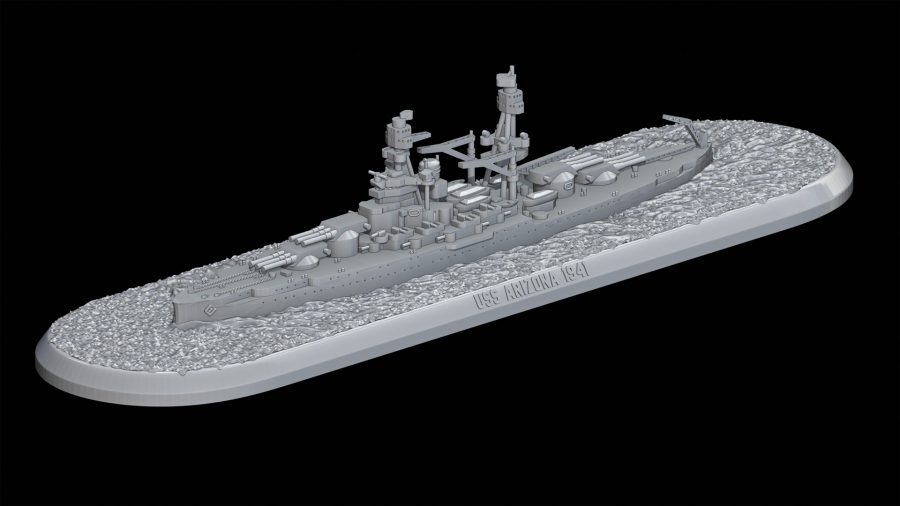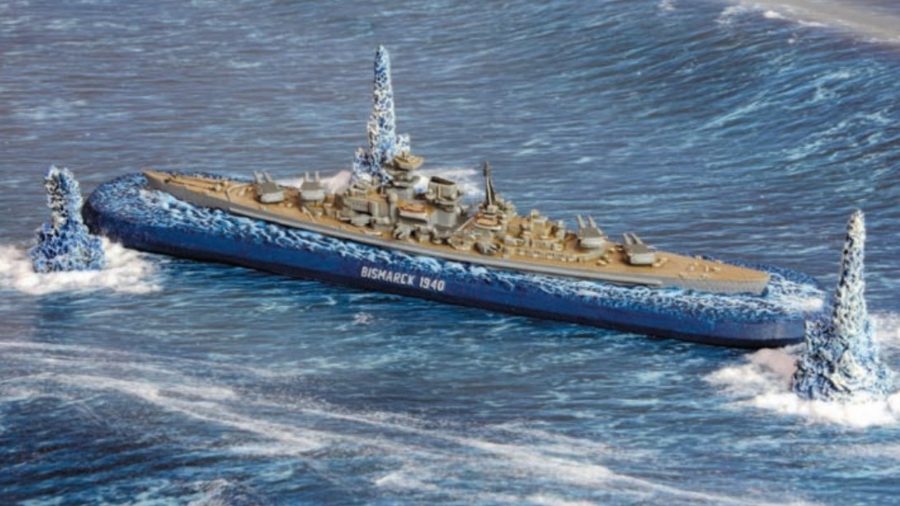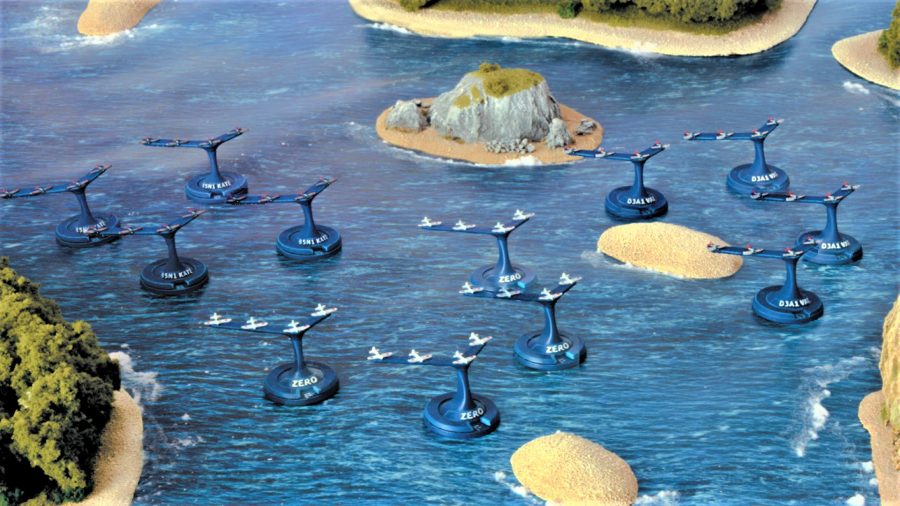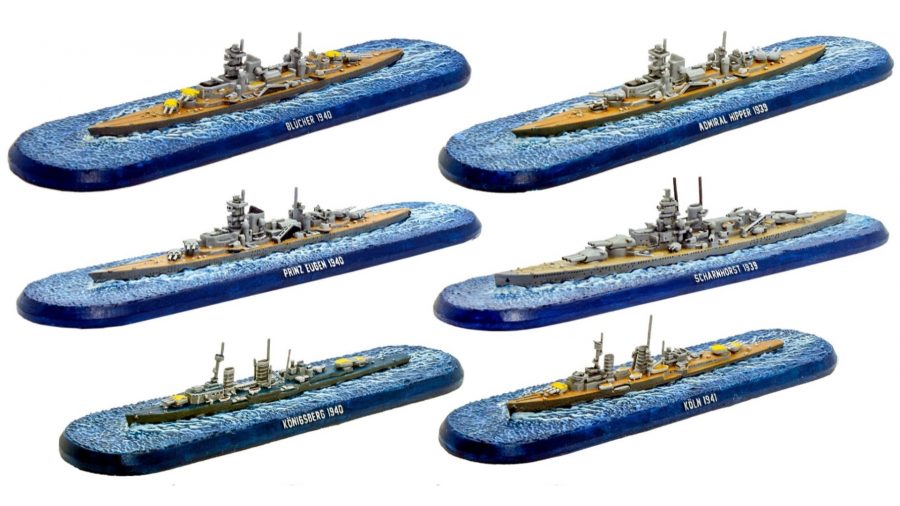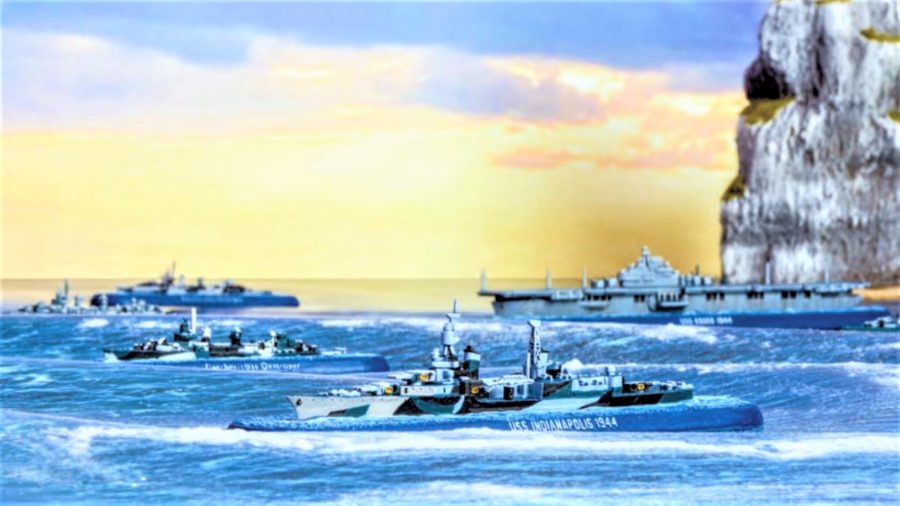There are a couple of 800-pound gorillas in the historical miniatures wargaming world, one of which is Warlord Games, out of Nottingham, UK. When this company speaks, people take notice, and this time around the messages are coming via semaphore. Yes, the long awaited high-seas maritime expansion to the firm’s Bolt Action product line, titled Victory at Sea, is finally here. Billed as a fast-play set of rules, Victory at Sea (or VAS) looks at naval conflict during World War II in its entirety, covering a lot more non-Pacific operations than did the famous documentary series.
Bottom line up front (BLUF) – VAS is another worthy addition to the Bolt Action series, not least because this $64 / £40 tome is far more than simply rules for fleet level combat.
Like previous Warlord entries, and following a trend within this hobby genre as a whole, VAS is sort of a one-stop-shop reference book, of which the actual rules to play the game are but a small part. Instead, many of its 278 pages (yes, that’s two hundred and seventy-eight) are devoted to history, scenarios and fleet lists. The actual ‘how to play the game’ portion runs from page 37 to page 75, plus a two-page reference sheet and a page of markers.
The rest of the book – outside your normal table of contents and index – provides a 29-page historical section as background to naval warfare in the Atlantic, Pacific and the Mediterranean, with fascinating sections on the Washington Naval Treaty and the non-participation of the French navy. Another 50 pages is devoted to 28 historical scenarios, some large and some quite small. Yes, the usual suspects, such as the River Platte, and Midway, are here, but also other, little-known affairs such as the battle of Calabria. Each scenario includes a very informative, full-colour deployment map with exact positions of each ship on the table by name. The schematic for Pearl Harbor is especially well done.
The real meat of VAS is its 144 pages’ worth of fleet lists. Nations covered include the British Royal Navy, US Navy, German Kriegsmarine, French Marine Nationale, Italian Regia Marina, Imperial Japanese Navy and civilian vessels (tramp freighters, Victory or Liberty Class transports, etc). Each national section is further divided into specific subsections for battleships, aircraft carriers, cruisers, destroyers, submarines, motor torpedo boats and aircraft, both land- and sea-based.
Within each of these sections, vessels are further categorized by class, such as the French Richelieu battleship class – which included the namesake, as well as the Jean Bart, plus the unfinished Clemanceau and Gascogne.
At this point, I might suggest that author Matthew Sprange has way too much time on his hands. The fleet lists are incredibly detailed and uber-comprehensive; they’re damn near worth the price of admission just for the information, even if you don’t play naval. Each chart not only has relevant historical data, but also the number of points it will take to put this ship on the table for the points-based matched games so dear to the heart of British players everywhere.
Pride of the seas: These are the best naval games around
The chart then looks at every individual major gun turret (plus light guns and anti-aircraft guns in aggregate) and rates them as to arc of fire, point blank, short, long, and extreme ranges, number of Attack Dice, number of Damage Dice, Armour Piercing capability and unique turret traits such as Fast Tracking. Also listed is the ship class’ Flank Speed in inches, Armour Rating, Hull Rating and unique Traits, such as having Armoured Decks.
Finally, the chart also lists how much any upgrades or downgrades to the ship will change its points cost. Using the Richelieu as an example, if you want the 1943 Free French upgrade – which included such perks as advanced radar and increased anti-air range – you’ll need to tender an extra 135 points on top of the 450 base rate.
And, as I said, we are talking extensive here. I swear, every combat vessel that floated for at least ten minutes must be listed here. I’d never heard of the Clemson-class destroyers deployed by the US Navy, but I have now – all 156 of them – and the author has listed every refit these tin cans went through by name on the stern. Also listed are a bunch of vessels that were planned, but never saw the light of day. Sure, most have heard of the proposed Graf Zeppelin-class aircraft carrier for the Kriegsmarine, but how about the Jade-class auxiliary carrier based on the Gneisenau passenger ship of the North German Loyd Line? Her sister passenger ship, the Scharnhorst, was actually converted to an aircraft carrier as planned – but by the Japanese, when they purchased her in 1943.
There is even a chart for specific types of shore batteries, such as the British ‘Winnie’ and ‘Pooh’ batteries,each mounting two 14-inch guns and costing 150 points a pop. Seriously, I’m surprised there isn’t a listing for tug boats. Of course talk – and print – is cheap, even if wrapped up in a hardback, full-colour, sumptuously designed presentation package with over-the-top production values.
Table tales: Why tabletop wargames tell the best stories
What’s more important is: “how does it play?” Actually, pretty darn well. The game strikes the right balance between historical accuracy and gameplay, at this level of command. Actual game procedures are easy and quick, but the decision-making process behind them can be brutal. This is as it should be, as fleet admirals were more interested in overall options, not specifics; in bringing as many guns to bear as possible, not determining the proper calibre for each tube firing.
To convey this, VAS has turns that consist of only four joint phases: the Initiative, Movement, Gunnery, and End Phases. For Initiative, opposing players roll a D10 with high die winning, and thus getting to move second (yes, second).
In the Movement portion of the turn, the player losing the Initiative picks one of their ships and moves it, then their opponent does the same, and this process continues until all ships on both sides have been moved, and no ship may pass. Movement is by typical rules for running and turning, or the player can select one special movement action instead. Some, such as Create Smoke, are automatic, while others, such as Come About (pushing the rudders to the max, allowing a near-90-degree turn) will require a die roll-off called a Crew Quality Check.
Gunnery is exactly what it seems (but is the most complex part of the game, so will be discussed below) while the End phase finds both players trying to apply Damage Control to stricken ships, or determining if any current damage escalates into a higher category. The Initiative winner checks all his ships first, followed by his opponent. Then the turn ends.
Now, back to Gunnery: the same alternating friendly/enemy sequence as found in Movement continues here, but this time, the player who won the Initiative picks one of their ships to fire first. For each weapons system – such as a single turret or aggregate light guns – they pick a target, calculating range and arc of fire.
Battle in a box: These are the best war board games
Then, for each, they roll a number of D6 equal to that specific gun’s Attack Dice number, with any die resulting in a modified result of 4 + scoring a hit. For each hit, another modified die roll is made and compared to the target’s Armor Score. One point is then deducted off the target’s Hull Rating for each successful die. Kill enough Hull points, and the ship will either become crippled or sink.
Taking our friendly French battleship Richelieu as an example once again, each of the vessel’s two primary turrets (mounting four 15 inch guns each) have a rating of four Attack Dice and three Damage Dice. Thus for each turret they would roll four dice to fire and, for each hit, three dice to determine damage. On the receiving end, you have to kill 95 Hull points to sink the thing and 31 to cripple it.
There are also, of course, Critical Hits, normally caused by a Gunnery D6 die roll of 6 and divided into four categories – Engine, Crew, Weapons and Vital Systems. Typical D10 die rolls could result in nothing at all, or egregious results like Rudder Damage, which forces a ship to move three inches ahead before it can attempt a turn. By far the scariest is the Vital Systems Critical Hit table, where you could actually have your conning tower blown away, meaning that ship can never receive any orders for the rest of the game. I had that happen twice over the last couple of days of playing.
There are other pieces of chrome, to be sure. Any vessel can have any number of special traits, such as Armored Decks, which negates the positive die roll modifier for enemy Plunging Fire and reduces the effectiveness of Japanese Kamikaze attacks. And, speaking of aircraft: yes, they are included in the game, just like submarines, but in a very generic, almost abstract way. This is in keeping with the game’s higher command echelon philosophy, so despite the fact that I know someone, somewhere is thinking right now about how to fuse Blood Red Skies into VAS, please don’t. VAS works just the way it’s supposed to.
As did my experience with the entire game, through two days of slinging GHQ 1/2400 scale Micronauts at each other – specifically, French and Italian surface fleets. The battles were evenly split, though someone really needs to bug the French about where they put the conning tower on their ships (ahem). Otherwise, all games moved quickly to a definite conclusion, and, although having to calculate each individual weapons system separately slowed things down somewhat, the “oh wow, no armour penetration table” simplicity of other processes more than made up for this. Well done.
A lick of colour: Read our beginner’s guide to painting miniatures
Now, a few thoughts on the VAS metal-resin miniatures by Warlord supporting the game. They are 1/800 scale, very nicely sculpted, and are produced on bases that mimic ocean waves, along with the name of the ship and the years of service.
This is one of the very few disappointments about the VAS line, but this is a matter of personal preference only. I like my miniature games to look as close to reality as possible, which is why I don’t care for flip up labels on the back of stands. The raised ocean platform with name detracts from this visual, as it seems to suggest the Richelieu trotted around the Atlantic on some sort of elevated dock (which obviously it did not). That said, consulting with several of my peeps reveals that many like this design feature, because of the ability to pick up the model by something other than the captain’s potted palms at the back of the conning tower.
Can’t argue with that, but if you are more aesthetically inclined, you can always use another miniatures line, such as GHQ Micronauts, and they work fine. Given VAS has continued the tradition of driving us Colonials bat-shit-crazy by NOT designating a scale, and saying the model is only an approximate location of the ship on the high seas, no harm, no foul. Cost varies, but something like the Italian battleship Vittorio Venito will set your account back $24.95 / £17.84. Otherwise, the game delivered as promised, so color me one happy camper (or bosun’s mate, as the case may be) – if not downright ecstatic. It was easy to learn, easier to play, fast, and seemed quite accurate for the level of command it represents. If I were to make one change, it would be to include the Voyénno-morskóy flot SSSR.
Indeed, the Russians had three battleships in service, and another three in various stages of completion, so a Black Sea or Baltic campaign was not out of the question, and would make for some fascinating battles on the tabletop.
Air, land and sea: These are the best WW2 games around
Looking forward, I can only hope this system is expanded to include not only World War I, but also the Russo-Japanese War (I would love to take a stab at Tsushima with VAS) and even the pre-Dreadnaught era. We’re talking some majorly large fleet actions here, so something like VAS and its “forest, not the trees” design philosophy seems a perfect fit.
And trust me, I’ll have shekels waiting.
